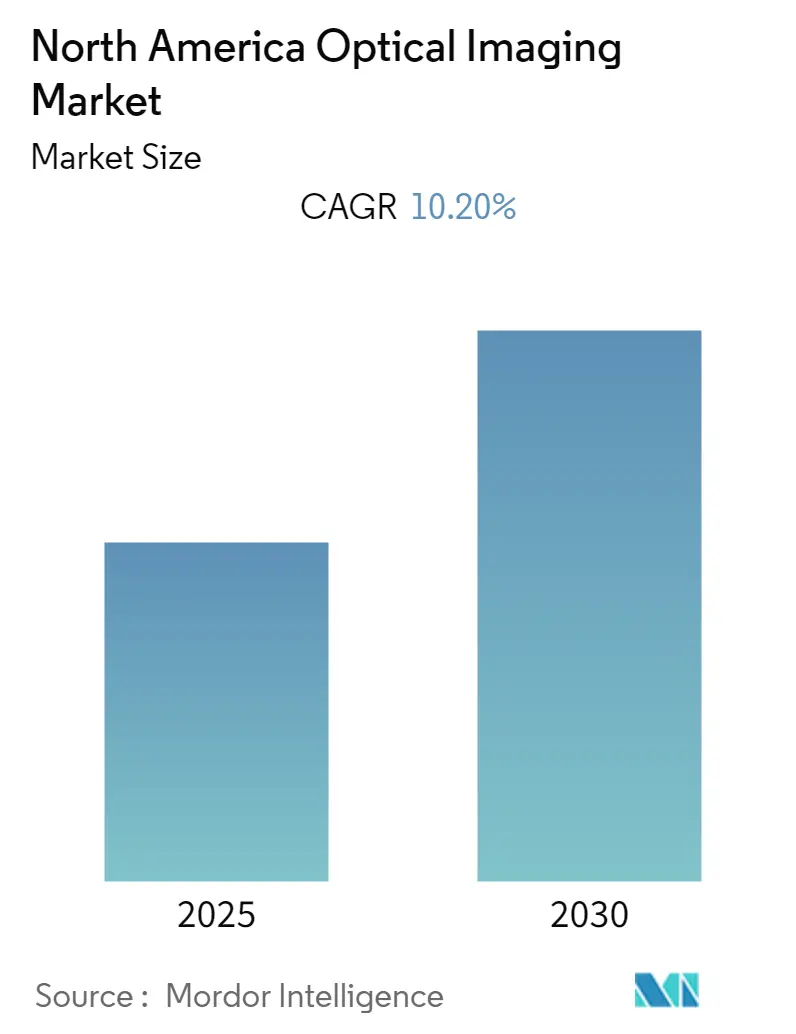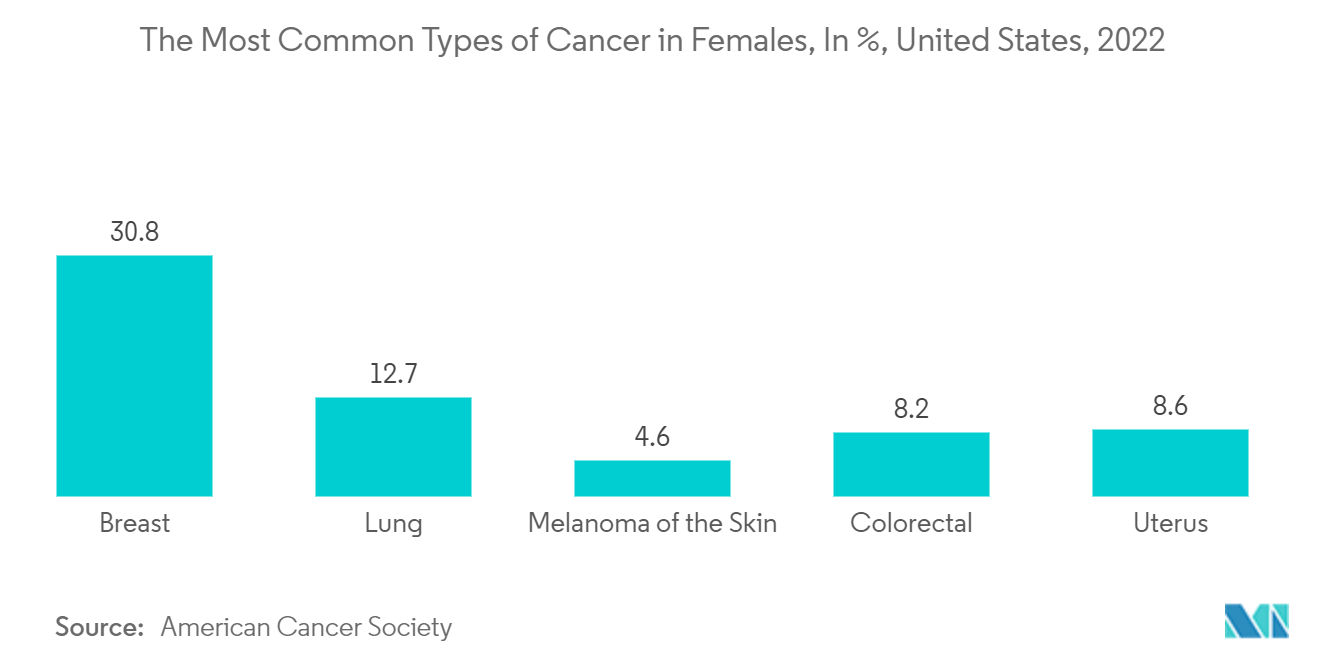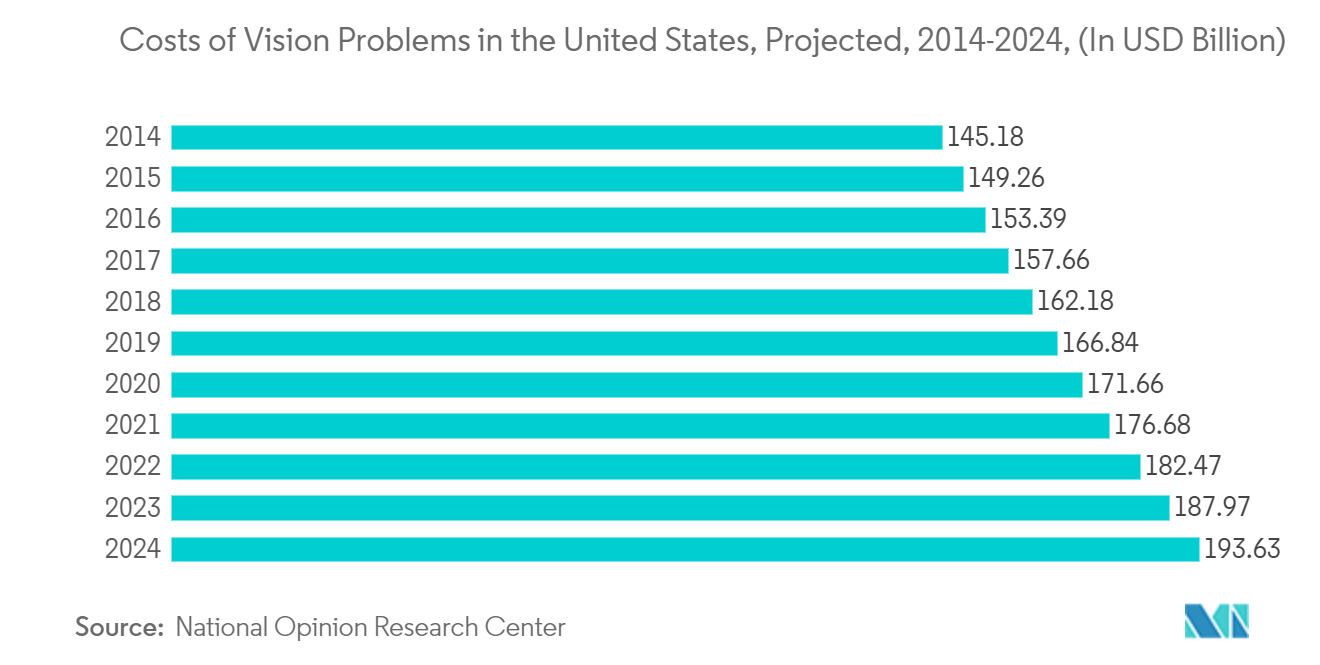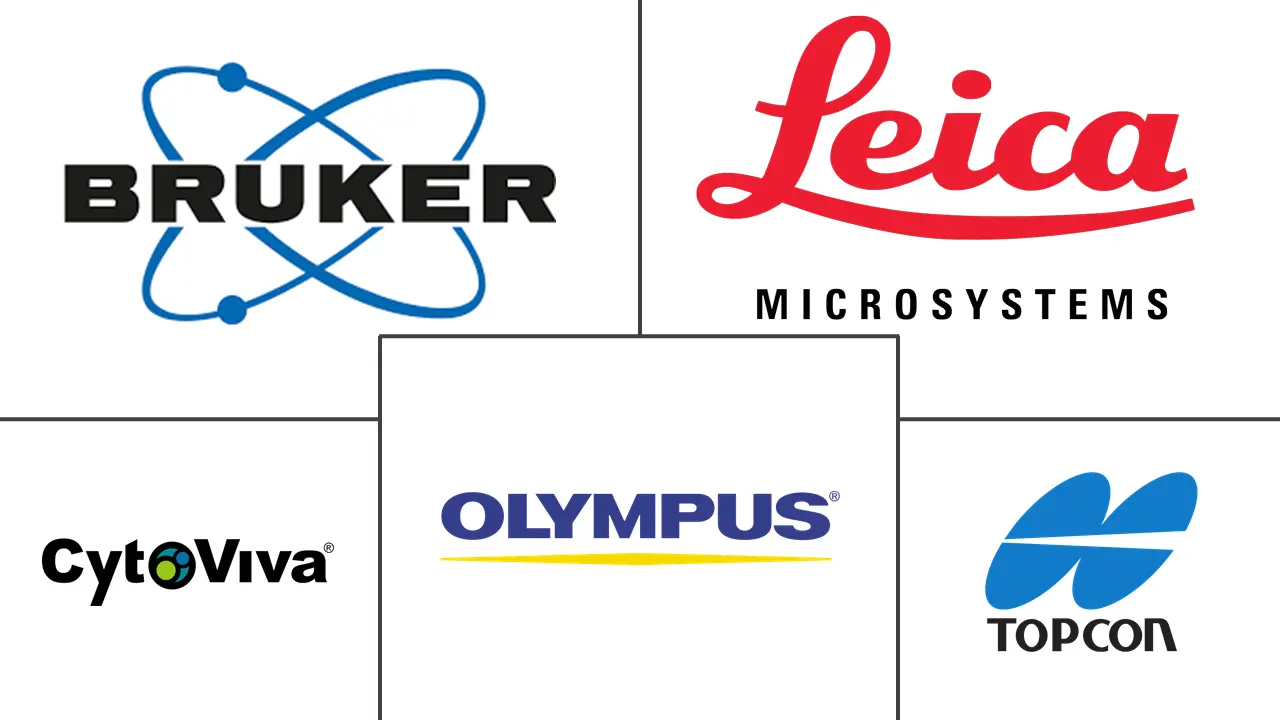
North America Optical Imaging Market Analysis by Mordor Intelligence
The North America Optical Imaging Market is expected to register a CAGR of 10.2% during the forecast period.
- Optical imaging is gaining popularity as it employs non-ionizing radiation, such as visible, ultraviolet, and infrared light, which considerably minimizes patient exposure to hazardous radiation. Optical imaging can be used for repeated procedures to monitor the progression of a disease or the results of treatment, as it is far safer than techniques that employ ionizing radiation, such as X-rays.
- The region is also witnessing a rise in investments, R&D activities, and technological advancements in the life sciences sector. For instance, in February 2022, BTR (Boston Technology Research) and SaMD announced raising USD 15 million in a Series A funding round.
- The funding would ensure that customers are prepared for the FDA's anticipated guidance to incentivize a move from traditional methods to new technologies. Such developments are likely to boost the growth of the market studied by accelerating the adoption of new technologies like optical imaging.
- Additionally, in January 2021, CARB-X awarded USD 578,000 to Accelerate Diagnostics, a USA-based biotech company, for developing new fiber optic technology to diagnose sepsis or the risk of sepsis.
- Further, optical imaging is beneficial for determining various soft tissue properties. As different soft tissues absorb and scatter light differently, optical imaging can detect metabolic abnormalities that are early indicators of abnormal organ and tissue functioning. Optical imaging can be combined with other imaging techniques to provide more information to clinicians and researchers working on complex experiments. Such advantages provided by optical imaging are expected to fuel the growth of the market studied.
- However, due to the COVID-19 pandemic, medical practices of all sizes were under tremendous strain as healthcare facilities in the region were overwhelmed by the large number of patients who visited them daily. The pandemic also increased the need for physicians and other healthcare professionals to maintain social distancing. Due to the pandemic, many imaging and diagnostic departments saw a sharp decline in optical imaging case volumes.
- Additionally, stringent regulatory approval procedures, hefty instrument costs, a scarcity of qualified operators, and insufficient reimbursements for optical imaging procedures hinder the growth of the market studied.
North America Optical Imaging Market Trends and Insights
Optical Imaging in Oncology is Expected to Witness Significant Growth
- According to National Cancer Institute, the most common cancers in the United States (listed in descending order) are breast cancer, lung and bronchus cancer, prostate cancer, colon and rectum cancer, melanoma of the skin, bladder cancer, non-Hodgkin lymphoma, kidney and renal pelvis cancer, endometrial cancer, leukemia, pancreatic cancer, thyroid cancer, and liver cancer.
- Additionally, researchers at Purdue University in Indiana, North America, developed equipment that uses optical imaging to assist surgeons in better mapping out bodily malignancies and understanding how specific diseases affect brain activity. The light becomes greatly dispersed during fluorescence imaging, limiting the amount of information a surgeon can obtain. Purdue technology solves this problem. This technique gives surgeons more precise information about tumors and brain cell activity, which can enhance patient outcomes.
- Optical imaging is a fast, inexpensive, and sensitive imaging approach for the non-invasive detection of cancers. Defining the margins of cancerous tissue using optical contrast agents can allow the surgeon to distinguish between normal and tumor tissue better. It also allows surgeons to avoid the unintentional removal of healthy tissue and prevent failure to maximize the removal of malignant tissue.
- Moreover, head and neck cancers have become a significant threat to human health in recent years. While surgery remains the first-line treatment option for patients with head and neck cancer, the limited resectable tissue mass and complex anatomy structures in the head and neck region put surgeons in a predicament between extensive resection and a better quality of life for the patient, as removing too much may negatively impact the patient's quality of life, and pulling too little may cause cancer to reoccur.
- Early detection and treatment of pre-malignant lesions and real-time in vivo detection of surgical margins during en-bloc resection could reduce the resection of normal tissues. Developments in optical hardware and reagents have created exceptional prospects for real-time pre-malignancies and cancer imaging in the clinic or operating room, with an understanding of head and neck oncology.

Ophthalmology Segment is Expected to Hold a Significant Market Share
- The soaring popularity of Optical Coherence Tomography, a non-invasive imaging technology used to obtain high-resolution cross-sectional images of the retina, and the rising prevalence of eye disorders as the regional senior population grows, are expected to aid the growth of the market studied.
- Based on the data provided by the Centers for Disease Control and Prevention (CDC), in the United States, common eye disorders include refractive errors, glaucoma, age-related macular degeneration, diabetic retinopathy, and cataracts.
- Additionally, 3.3 million Americans have open-angle glaucoma, according to Prevent Blindness, a prominent volunteer eye health and safety organization devoted to preventing blindness and preserving sight. For instance, in October 2022, Nanoscope Technologies LLC, a biotechnology company working on gene therapies for the treatment of chronic diseases, announced that it had been awarded a USD 1.5 million SBIR Direct-to-Phase II grant from the NIH in support of its advancement of glaucoma therapy using engineered mechanosensitive channels (EMC).
- In addition, the ophthalmic industry is seeing an increase in the incorporation of AI into diagnostic techniques. Inspired by the human multilayered neuronal system, AI has significantly improved some visual and auditory recognition tasks. AI can comprehensively, quickly, and non-invasively examine digital data in various tasks.

Competitive Landscape
The North American optical imaging market is moderately fragmented, with prominent players like Carl Zeiss Meditec AG, ASE Optics Inc., Cytoviva Inc., Heidelberg Engineering Inc., etc. The companies must leverage their technological capabilities and industry experience to innovate advanced products that cater to complex issues to diversify their customer base and capture a wider geographic area.
- In October 2022, Teledyne Technologies Incorporated announced the acquisition of ETM-Electromatic Inc. ("ETM") by a wholly-owned subsidiary. ETM, based in Newark, California, creates high-power microwave and high-energy X-ray subsystems for cancer treatment, defense, and X-ray security. Teledyne will also acquire ETM's purpose-built manufacturing plant from an affiliate of ETM and its owners. ETM adds a distinct value to its healthcare imaging and defense electronics businesses.
- In January 2021, Olympus Corporation sold its imaging division to Japan Industrial Partners Inc. A legal agreement that both parties signed served as the basis for the final transfer. Following the handover, OM Digital Solutions Corporation took over Olympus' Imaging division.
- In January 2021, Leica Microsystems announced a partnership with Imperial College in optical imaging and its use in research and innovation to set up a dedicated imaging hub equipped with advanced confocal and widefield microscopy systems.
North America Optical Imaging Industry Leaders
Topcon Corporation
Bruker Corporation
Leica Microsystems
CytoViva, Inc.
Olympus Corporation
- *Disclaimer: Major Players sorted in no particular order
.webp)
Recent Industry Developments
- January 2022: Bruker Corporation announced the release of the JPK NanoWizard V BioAFM, a very fast, automated BioAFM that can optionally be fully integrated with advanced optical microscopes. It enables rapid, quantitative mechanical measurements and the analysis of dynamics on samples ranging in size from sub-molecular to cells and tissues.
- July 2021: Topcon Corporation acquired VISIA Imaging Srl, an ophthalmic device manufacturer. The acquisition strengthened Topcon's anterior segment device and software development and manufacturing capabilities, complementing the company's robust portfolio of fundus imaging technologies, including fundus cameras and optical coherence tomography (OCT).
North America Optical Imaging Market Report Scope
Optical imaging is a newly developed non-invasive technique for taking pictures of the body's internal organs. Visible light and photons are combined to obtain a comprehensive image of internal organs and tissues. Additionally, pictures of smaller structures like molecules and cells are taken. Optical imaging, which uses photon properties like absorption and scattering, measures and perceives the characteristics of organs and soft tissues. Although it is still developing, optical imaging technology has several technological advantages over other imaging technologies.
The North American optical imaging market is segmented by Technology (Photoacoustic Tomography, Optical Coherence Tomography, Hyperspectral Imaging, Near-infrared Spectroscopy), Product (Imaging Systems, Illumination Systems, Lenses, Optical Imaging Software, Other Products), Application Area (Ophthalmology, Oncology, Cardiology, Dermatology, Neurology, Dentistry, Other Application Areas), End-user Industry (Hospitals and Clinics, Research and Diagnostic Laboratories, Pharmaceutical Industry, Biotechnology Companies), and Country (United States, Canada). The report also covers the assessment of COVID-19 in the North American optical imaging market.
The market sizes and forecasts are provided in terms of value (USD million) for all the above segments.
| Photoacoustic Tomography |
| Optical Coherence Tomography |
| Hyperspectral Imaging |
| Near-infrared Spectroscopy |
| Imaging Systems |
| Illumination Systems |
| Lenses |
| Optical Imaging Software |
| Other Products |
| Ophthalmology |
| Oncology |
| Cardiology |
| Dermatology |
| Neurology |
| Dentistry |
| Other Application Areas |
| Hospitals and Clinics |
| Research and Diagnostic Laboratories |
| Pharmaceutical Industry |
| Biotechnology Companies |
| United States |
| Canada |
| By Technology | Photoacoustic Tomography |
| Optical Coherence Tomography | |
| Hyperspectral Imaging | |
| Near-infrared Spectroscopy | |
| By Product | Imaging Systems |
| Illumination Systems | |
| Lenses | |
| Optical Imaging Software | |
| Other Products | |
| By Application Area | Ophthalmology |
| Oncology | |
| Cardiology | |
| Dermatology | |
| Neurology | |
| Dentistry | |
| Other Application Areas | |
| By End-user Industry | Hospitals and Clinics |
| Research and Diagnostic Laboratories | |
| Pharmaceutical Industry | |
| Biotechnology Companies | |
| By Country | United States |
| Canada |
Key Questions Answered in the Report
What is the current North America Optical Imaging Market size?
The North America Optical Imaging Market is projected to register a CAGR of 10.2% during the forecast period (2025-2030)
Who are the key players in North America Optical Imaging Market?
Topcon Corporation, Bruker Corporation, Leica Microsystems, CytoViva, Inc. and Olympus Corporation are the major companies operating in the North America Optical Imaging Market.
What years does this North America Optical Imaging Market cover?
The report covers the North America Optical Imaging Market historical market size for years: 2019, 2020, 2021, 2022, 2023 and 2024. The report also forecasts the North America Optical Imaging Market size for years: 2025, 2026, 2027, 2028, 2029 and 2030.
Page last updated on:
North America Optical Imaging Market Report
Statistics for the 2025 North America Optical Imaging market share, size and revenue growth rate, created by Mordor Intelligence™ Industry Reports. North America Optical Imaging analysis includes a market forecast outlook for 2025 to 2030 and historical overview. Get a sample of this industry analysis as a free report PDF download.



